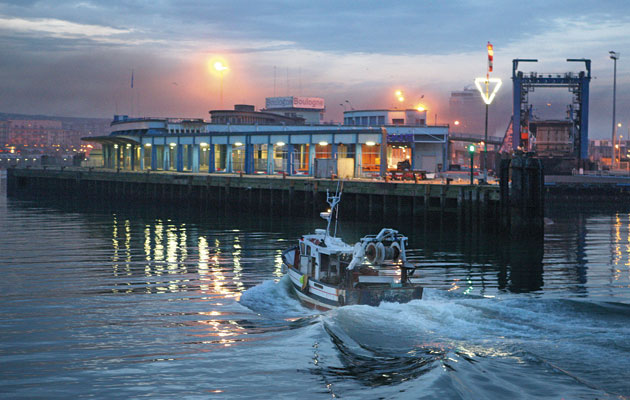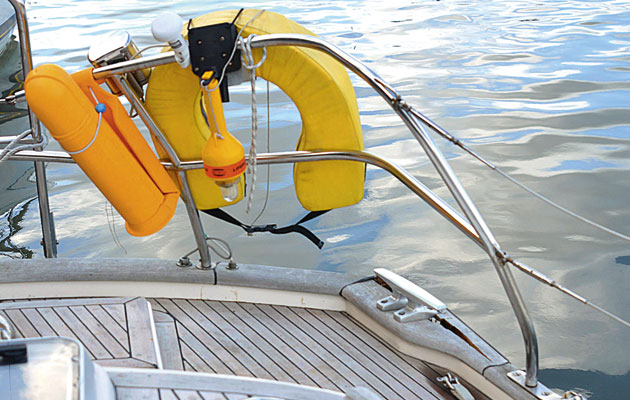Anchored off Boulogne with a disabled engine, Richard Brown thought the worst was over. Then his yacht was in collision with a trawler…
Collision with a trawler
My wife and I left Dieppe aboard our Hallberg-Rassy 36, Christine Anne. bound for Boulogne with a forecast of gales much later. The tide was perfect and I assumed we would arrive long before the bad weather. The forecast, however, was wrong. A force 8 arrived early and provided very fast and exhilarating sailing: 10-11 knots over the ground.
We arrived around lunch, entered the outer harbour, started the engine and almost immediately the high temperature alarm sounded. This was not a false alarm but very real, with steam emerging from the engine room. I decided that it was essential to anchor and stop the engine before any real damage was done so we motored to the edge of the channel and dropped the anchor. It was now blowing force 9 and very uncomfortable in the outer harbour.
‘Stay in the outer harbour’
I called the harbourmaster, told him of our predicament and gave him our GPS position. He agreed that the safest option was to stay in that position until the wind abated, as it was forecast to do the following morning, when we could move into the marina. About dusk the harbour master called us and confirmed that we should remain in position and checked with us that our anchor light was on.
At about 0330, a large fishing boat hit our port quarter, demolishing the pushpit and inflicting superficial damage to the teak toerail and some GRP. Before I could call him, the harbourmaster called me to say the lifeboat would be with us in a few minutes. We raised a very well-set anchor and were towed into the inner harbour.
There was a suggestion that we may have dragged into the fairway. We certainly didn’t, but because I hadn’t logged our GPS position through the night, we had no way of proving it.
The cause of all our troubles was the failure of a simple plastic fitting that connects the closed-circuit coolant to the calorifier. This fitting is difficult to access but can be changed without dismantling any other components. The return fitting, also plastic, is more accessible and when I tested mine, it also broke off very easily.
Finally, the marina staff at Boulogne could not have been more helpful.
Lessons learned
Anchoring was my only choice. Although we checked the GPS regularly, our position had not changed so we did not log it throughout the night. In future I will log the position so it is recorded that we are secure and not dragging.
I propose to change all my navigation lights to LEDs, which will be brighter and consume less power. It might help.
The anchor light is about 15 metres above sea level, above normal sight level from an approaching vessel. A lower light would not be visible through 360°. In a similar situation I would be tempted to add a second anchor light, perhaps on the boom, regardless of Colregs.
If we had been hit forward, the damage might have caused the boat to sink. Being closer to 80 years old than 70, I’m not sure I would be able to launch the liferaft from the coachroof, so
I’ve relocated the liferaft to the pushpit.
Apart for routine maintenance I have done nothing to my 23-year-old engine. Until last August, it had never failed. If you have a Volvo MD22 engine, check the cooling system-to-calorifier connections. If they’re plastic, have them changed.
How to be seen at anchor
Seamanship expert Bill Anderson offers advice
Masthead light ‘not ideal’
A single white light 15 metres or so above deck is not ideal, as skippers tend to look ahead rather than up. The fishing boat had just left an area of quite high ambient light, which might have helped her skipper to see the anchored yacht but won’t have done much for his night vision.
‘Illuminate her decks’
The Colregs seems to acknowledge that white anchor lights are sometimes insufficient. Rule 30(c) says that ‘A vessel at anchor may, and a vessel of 100 metres and more in length shall, also use the available working or equivalent lights to illuminate her decks.’
Deck lights ‘out of fashion’
Deck working lights, fitted on the underside of spreaders or below the steaming light, used to be quite standard equipment but they seem to have gone out of fashion, a side effect perhaps of furling headsails and reefing lines led aft to the cockpit. They were extremely useful, and perfectly legal, as additional illumination when at anchor, particularly in areas with much brighter lights along the shore.
All-night anchor watch
If you don’t have deck working lights and have to anchor very close to a busy fairway, the best defence would probably be an anchor watch with a powerful torch. How easy it is to be wise after the event!











